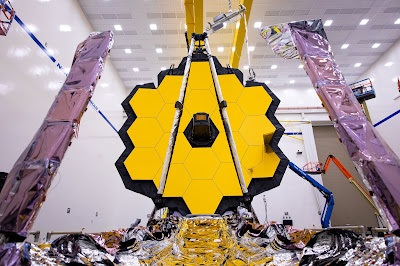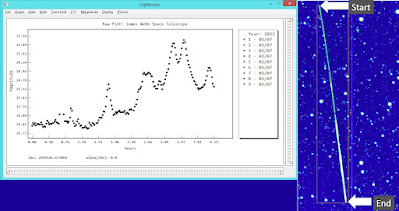Named after James E. Webb, who was the administrator of NASA from 1961 to 1968, the James Webb Space Telescope (JWST) is a space telescope intended to succeed the Hubble Space Telescope (HST). The JWST with its primary mirror of 6.5 meters (made of 18 hexagonal gold-plated beryllium segments) and a sunshield the size of a tennis court, promises to usher in a new era of astronomy with its capability to observe some of the oldest, most distant objects in the Universe, viewing up to 100 times fainter than HST. After three decades from conception through design, JWST was launched December 25, 2021 and will orbit the Sun near the second Lagrange point (L2) of the Sun-Earth system.
 |
| Credit: Northrop Grumman, NASA/Chris Gunn |
JWST can be easily seen from Earth as its magnitude is now around 14. The image and the animation below show the James Webb Space Telescope travelling towards its final destination. The images were taken on Jan 12, 2022 at 02:30 UTC by Ernesto Guido, Marco Rocchetto and Adriano Valvasori via Telescope Live using the Planewave CDK24 60-cm telescope installed at El Sauce Observatory, Chile (CHI-1). Click on each image for a bigger version.
At the imaging time, JWST was around 741,900 miles away from Earth, almost 82 percent of the way to its destination. You can see where is Webb at any time on this webpage.
Below another image of JWST imaged by A. Valvasori & E. Guido via ALMO observatoy (MPC code G18 - Italy) on January 07, 2022
Below a lightcurve of JWST spanning about 4 hours. 179 exposures, each 60sec in duration obtained by Daniel Parrott using his software TYCHO
By Ernesto Guido




